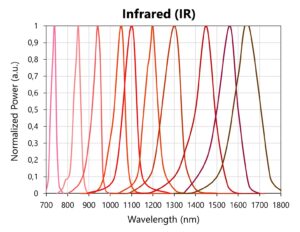The infrared spectral region is considered to be the part of the electromagnetic spectrum that covers from 700 nm (limit for red) to 1,000 µm. Within the infrared, usually three bands can be distinguished: near infrared (NIR, 780 nm – 3 µm), mid-infrared (MIR, 3 µm – 50 µm), and far infrared (FIR, 50 µm – 1,000 µm). The ranges between parentheses correspond to ISO 20473 definitions, because other organisms establish other limits for these regions.
The aim of this post is to explain the basic operation of the most common infrared light sources used by researchers, as well as their characteristics and main applications. These light sources are the following:
• Halogen lamps: they are incandescent lamps, that is, light sources whose operation is based on the radiation emitted by an electrically heated filament. This filament is in a bulb filled with a gas mixture that includes a halogen gas, hence the name. The filament is made of tungsten, so the term tungsten halogen lamp can also be employed. Its operation is based on a cycle: the electrical current heats the filament and vaporizes the tungsten, which then reacts with the halogen gas and is redeposited on the filament.
Halogen lamps are a good option for spectroscopy applications in the agricultural or medical field, as they have a continuous spectral distribution from visible to infrared light, typically covering from 400 nm to 2500 nm. You can check Pyroistech halogen source in this link.

On the other hand, xenon lamps, which are gas discharge lamps, cover a similar wavelength range (0.2 – 2.0 µm), although depending on the type, their spectrum in the infrared is not vey smooth.
• LEDs: they are basically a PN junction (semiconductor with a positively doped area, P, and a negatively doped area, N) that emits light by spontaneous emission when an electric current flows through it. NIR LEDs employ materials such as AlGaAs (aluminum gallium arsenide) or InGaAsP (indium gallium arsenide phosphide) as the semiconductor material. There are also NIR LEDs based on phosphor conversion, that is, LEDs that emit ultraviolet or blue light, but with a phosphor coating that absorbs these wavelengths and emits light in the NIR.
LED sources main advantages are their high spectral stability, long lifetime, low electrical energy consumption and compact size. They are employed for studying photodegradation (for instance, in the case of lipids) of for photochemistry applications, among others. You can check Pyroistech range of NIR LED sources in this link. We have recently added new wavelengths in the 1100 nm – 1650 nm range.

• Lasers: they are also a PN junction but in this case there are two mirrors, and a waveguide between the P and N sections. The two mirrors are selective in wavelength, which leads to a narrow spectral width, and the waveguide restricts the direction in which the light can propagate. The main phenomenon behind the laser operation is the stimulated emission (“laser” means light amplification by stimulated emission of radiation), which is achieved by recirculating the light in the cavity created by the two mirrors.
There are different types of lasers, but regarding the infrared, two of the most important ones are quantum cascade lasers and solid-state lasers. Quantum cascade lasers usually work in the mid-infrared, and one of its main application is gas or pollutants detection. Solid-state lasers work in the 100 nm – 2400 nm range and have applications such as pulse generation or disease diagnosis based on diffuse reflectance.
• SLDs: they are PN junction with facets as the laser, but the facets are tilted, so amplified spontaneous emission is the dominant effect in their operation. This phenomenon is also known as superluminescence, thus the name superluminescent LED (abbreviated as SLD or SLED). SLDs have a high spatial coherence, which implies a strong directionality of the light beam, and they mostly work in the NIR.
SLD sources are employed in high demanding applications where single mode fiber is used, including optical fiber testing, fiber sensors, optical coherence tomography (OCT), or fiber optic gyroscopes (FOG). You can check Pyroistech SLD sources in this link. We offer the possibility of combining up to 8 SLDs in a source to obtain your desired spectrum.

• Globar: the term “globar” comes from the combination of the words “glow” and “bar”. It receives this name because it consists of a rod (a “bar”), usually made of silicon carbide, that is heated to temperatures between 1000°C and 1650°C, and emits light (“glows”) through the interaction with a downstream interference filter. In order to reach the required temperatures, a nichrome wire heater is usually employed (it offers a very high resistance, so it generates a large amount of heat when current flows through it).
Globars are an ideal source for mid-infrared spectroscopy as they can cover from 1 µm to 50 µm. The main applications include Fourier transform infrared spectroscopy, infrared spectroscopy and heating.
Written by J.J. Imas
Bibliography
[2] What is a Globar? AZO Optics
[3] What is a phosphor? Lumileds
[4] Quantum Cascade Lasers RP Photonics
[5] SLD lighting principles unveiled Pyroistech
[6] Superluminescent diodes (SLD/SLED) applications Pyroistech
